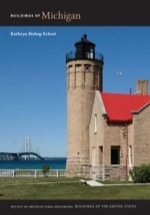
From upstate New York, the Kirbys brought a taste for and knowledge of coursed cobblestone construction technique and applied it in their Greek Revival farmstead at Hillsdale. Born in England, William R. Kirby (1805–1888) and his wife, Hannah (1801–1876), came to the United States in 1827. They settled first in Ogdensburg, New York, but in 1831 moved to Lake County, Ohio. In 1835, after William Kirby made a land-hunting trip to the area and purchased his lands at the federal land office in Monroe, the Kirbys became the first European settlers in the wilderness near Hillsdale. They put up a small log structure in which they lived until the cobblestone house was built. One of the little more than two dozen remaining from many cobblestone buildings that were constructed in the southern three tiers of counties east of Battle Creek, this house rests on a fieldstone foundation and is constructed of cut fieldstone walls faced with a veneer of rounded cobblestones laid in horizontal courses. The quoins and the window and doorway lintels and sills are fashioned of cut yellow sandstone from the Stoney Point quarries near Mosherville, twelve miles away. The house has a two-story, end-gable main section joined by a one-story wing and rear ell. Greek Revival elements are the ample entablature and returns and the frieze-band windows.

